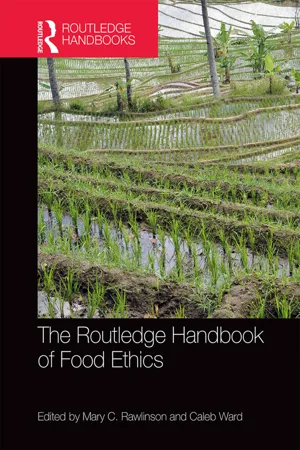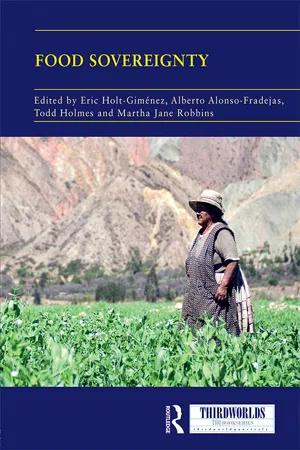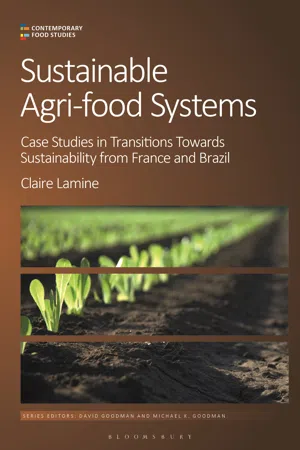Food Movements
Food movements refer to collective efforts by individuals, organizations, and communities to advocate for changes in the food system. These movements often focus on issues such as sustainable agriculture, food justice, and access to healthy, locally produced food. They aim to address social, economic, and environmental concerns related to food production, distribution, and consumption.
6 Key excerpts on "Food Movements"
- eBook - ePub
- Mary Rawlinson, Caleb Ward, Mary Rawlinson, Caleb Ward(Authors)
- 2016(Publication Date)
- Routledge(Publisher)
...35 Individual and Community Identity in Food Sovereignty The possibilities and pitfalls of translating a rural social movement Ian Werkheiser DOI: 10.4324/9781315745503-35 Food sovereignty is a growing, vibrant discourse in food justice. International organizations such as La Vía Campesina connect hundreds of local food sovereignty groups all over the world; food sovereignty as a concept has been included in the Ecuadorian and Venezuelan constitutions; and it has gained increasing currency among academics. However, food sovereignty has its critics. Some argue that the movement, which addresses a wide variety of environmental and social ills, is too diverse to be sensibly described as being about food. Activists respond in part that due to certain characteristics of food, truly reforming the food system without addressing these wider issues is impossible. Further, certain characteristics of food allow it to act as a central boundary object, making it an ideal candidate to provide a frame with which to address a wide range of injustices. Food sovereignty, they argue, must push toward a radical re-imagining of society. Another objection arises in response to this view. Some worry that these connections between food and wider issues might only be natural ones to make for the rural subsistence food producers who started the food sovereignty movement; food sovereignty as it is pursued by activists may be less salient for other peoples in other places. If this is right, then food sovereignty may be an effective social movement in some contexts, but it would not be as promising a candidate for a global movement as it is purported to be. This chapter addresses these concerns by exploring what food sovereignty is, and how it uses an imaginary of food to ground and motivate the movement. It then looks at how and how well food sovereignty translates into contexts other than those in which the discourse first emerged...
- eBook - ePub
Food Sovereignty
Convergence and Contradictions, Condition and Challenges
- Eric Holt-Gimenez, Alberto Alonso-Fradejas, Todd Holmes, Martha Jane Robbins(Authors)
- 2018(Publication Date)
- Routledge(Publisher)
...Friedmann argues that ‘the dominant tendency is towards distance and durability, the suppression of particularities of time and place in both agriculture and diets. More rapidly and deeply than before, transnational agrifood capitals disconnect production from consumption and relink them through buying and selling’. 61 Locality and seasonality are cited as responses to features of geographical distancing in the industrial food system and, in this way, localisation is proposed as an oppositional force to distance and durability. 62 Local Food Movements tackle the distance between producers and consumers through direct marketing and the social re-embedding of food systems. Hinrichs asks difficult questions about who benefits in these local food transactions, however, and warns that social embeddedness is often taken for granted and generalised, when it should be assessed more vigorously. 63 Local Food Movements may heighten distancing through their ‘missionary impulses’, according to Guthman’s scathing critique of local food system practices in the USA as racially marginalising and exclusionary. 64 Allen and Wilson suggest that many local food initiatives may reinforce existing inequalities of race and class rather than challenging them, because of the focus on consumer choice that ignores historically constructed inequalities. They posit that food sovereignty and other initiatives centred in the global South are more attuned to the importance of dealing with inequality. 65 In contrast, Holt-Gimenez and Shattuck characterise the food justice movements as more concerned with marginalised people and their access to food and question the notion that they are predominantly made up of elites...
- eBook - ePub
Sustainable Food Systems
Building a New Paradigm
- Terry Marsden, Adrian Morley, Terry Marsden, Adrian Morley(Authors)
- 2014(Publication Date)
- Routledge(Publisher)
...Hence there is a conceptual need to interrelate food security with food sustainability and to link this to space and place. It is not that the sustainability paradigm should fall into the ‘local trap’ of always emphasising the positives of localising supply networks, but rather it is to reassess the food ‘equations’ and relationships between production spaces and consumption spaces. Wayne Roberts, the veteran Toronto food campaigner puts it well when he argues that we need the impoverished ‘urban food consumer’ to become a more knowledgeable and empowered producer of their own and their families' health and well-being (Roberts, 2008). Simultaneously we might argue that we need the ‘rural producer’ to become the more empowered and multifunctional bearer of sustainable goods and services for rural and urban impoverished groups (Franklin and Morgan, Chapter 8, this volume). So far, notwithstanding some criticisms of being partly in the hands of neoliberalism (see Guthman, 2008) the alternative Food Movements, all in their varied and multifaceted ways, are creating new spatial and social connections. Hence, alternative Food Movements are a critical innovative vehicle for showing us ways of creating a real sustainable food paradigm, partly by meeting the demands of food (in)security and sustainability at the same time. They do so, also, by creating new linkages in and across urban and rural spaces, overturning our established spatial theories and supply chain models. Hence it is necessary for the development of a sustainable food paradigm to re-centre food insecurity within the broader societal and governance context of widening social and spatial inequalities and the politics of care (see Morgan and Morley, Chapter 4, this volume), while at the same time looking at ways in which, through the necessary and diverse sustainable food transformation, we could also see alternatives to these widening and wasteful disparities...
- Philip Sloan, Willy Legrand, Clare Hindley, Philip Sloan, Willy Legrand, Clare Hindley(Authors)
- 2015(Publication Date)
- Routledge(Publisher)
...Food Movements DOI: 10.4324/9780203795699-13 The average person is still under the aberrant delusion that food should be somebody else’s responsibility until I’m ready to eat it. Joel Salatin, Folks, This Ain’t Normal: A Farmer’s Advice for Happier Hens, Healthier People, and a Better World (Center Street, 2011) Food Movements and initiatives are increasingly changing the landscape of food production and consumption. This chapter analyses their impacts and feasibility on both a local and global scale. Maryam Fotouhinia Yepes examines vegetarianism and veganism as public awareness increases of the environmental impacts of meat production and consumption. The negative effects on the environment combined with increasing obesity and health problems have led to interest in plant-based alternatives to meat. The hospitality industry is expected to react and play an important role in environmental and public health issues. Jan Arend Schulp presents a case study on locavorism in the Netherlands, examining the options local food presents and asking the question whether the Netherlands could feed itself. Imports and domestic transportation are considered along with the real outcomes of urban framing. The analysis concentrates on the issue of whether locavorism can really work. Sandra J. Cooper work focuses on spas as an important part of the hospitality industry that have so far concentrated on healthy lifestyles rather than food choices. As spa customers provide a clientele open to advice in lifestyle and nutrition, their role as a forerunner in sustainable food is analysed...
- eBook - ePub
Sustainable Agri-food Systems
Case Studies in Transitions Towards Sustainability from France and Brazil
- Claire Lamine(Author)
- 2020(Publication Date)
- Bloomsbury Academic(Publisher)
...civil society, family farmers movements, the academia and, of course, the policy makers and institutions themselves) and articulate the different claims (food security, family agriculture and agroecology). The articulation of these claims allow for a greater legitimacy than each (group and claim) would have achieved separately. Interestingly, the main theme of the CONSEA national conference in 2015 was Comida de verdade na cidade e no campo (True food in the city and in the country), thus clearly linking the access-to-food and right-to-food issues to farming and environmental ones. The preparatory documents and the debates held during this national conference aimed at establishing new bases for a production and consumption model respecting the principles of food sovereignty, sustainability, climatic and social justice and social participation (Pinton and Sencébé 2019). An analysis of the role of social movement s in the elaboration of public policies focused on food security shows that this issue appeared as an ‘obligatory point de passage’ for diverse social groups and social movements defending their own categorical rights (i.e. landless movement, family farmers, rural youth, rural women, indigenous people, slave descendants, etc.). Agroecology later on appeared as a central operator of the convergence of different social movements involved in food security issues (Pinton and Sencébé 2019). The same could symmetrically be said when analysed from the perspective of agroecology, where food security and sovereignty may also appear as a central operator of the convergence of different social movements linked to agroecology. However, the process of convergence was long and by no means straightforward...
- eBook - ePub
Local Food
How to Make it Happen in Your Community
- Tamzin Pinkerton, Rob Hopkins(Authors)
- 2009(Publication Date)
- Green Books(Publisher)
...Chapter 1 THE LOCAL FOOD MOVEMENT If fresh food is necessary to health in man and beast, then that food must be provided not only from our own soil but as near as possible to the sources of consumption. If this involves fewer imports and consequent repercussions on exports then it is industry that must be readjusted to the needs of food. If such readjustment involves the decentralisation of industry and the re-opening of local mills and slaughter-houses, then the health of the nation is more important than any large combine. Lady Eve Balfour, founder of the Soil Association, 1943 Given the degree to which the modern food system has become dependent on fossil fuels, many proposals for de-linking food and fossil fuels are likely to appear radical. However, efforts toward this end must be judged not by the degree to which they preserve the status quo, but by their likely ability to solve the fundamental challenge that will face us: the need to feed a global population of seven billion with a diminishing supply of fuels available to fertilise, plough, and irrigate fields and to harvest and transport crops. Richard Heinberg and Michael Bomford, 2009 1 Food shapes and is shaped by many areas of our lives, from how we organise our days to the topography of our land, and much in between – our physical and emotional health; the climate; the quality of our air, water and soil; the diversity of the wildlife; the structure of our economies and the closeness of our communities. So it is perhaps not surprising that as change to the globalised, industrial food system is made inevitable by the limits of its own excesses (as discussed in the Introduction), one of the most popular focuses and starting points for many community-strengthening projects is the transformation and redefinition of the community’s relationship to food – how it chooses to sow, grow, fertilise, harvest, sell, transport, source, buy, cook or eat it...





